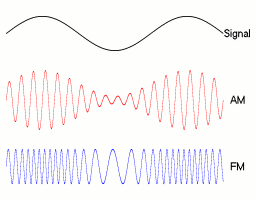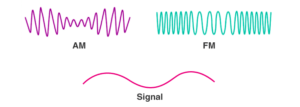- What are the elements of communication systems? Explain with classifications of communication systems
- What is the Frequency Spectrum of Communication Systems? Why Modulation is necessary in wireless transmission?
- What is Amplitude Modulation? Complete Mathematical Derivation of AM Wave
- What is the Importance of Side Bands in Amplitude Modulation? What are the types of AM?
- What is Frequency Modulation? Explain the process with diagram and mathematical analysis
- What is Satellite communication? Give Detailed explanation with diagram and mathematical analysis
There is a great importance of sidebands in amplitude modulation. The sidebands in AM decide the bandwidth of AM wave. Also the modulation index ‘m’ in AM process decides the three types of amplitude modulation.
About Sidebands
Sidebands give us the idea of bandwidth of AM wave. There are two types of sidebands in AM, the upper sideband (USB) and the lower sideband (LSB).
Useful information i.e. modulating signal is available only in sidebands. It means that the modulating signal fm contains only in USB and LSB.
So if we apply 100W transmission energy in AM, then ⅔ energy is consumed (or wasted) by unmodulated carrier signal fc.
The remaining ⅓ energy is divided into the useful part of AM wave i.e. the two side bands. So each side band gets only ⅓ transmitted energy.
However, as modulation index ‘m’ decreases, less power is carried by sidebands.
Types of Amplitude Modulation
The upper and lower sidebands produced in AM wave can be calculated as follows:
The Lower Side Band (LSB): ωc – ωm = 2π.( fc – fm )
And the Upper Side Band (USB): ωc + ωm = 2π.( fc + fm )
The difference of USB and LSB is called as the bandwidth –
BW = (2π.( fc + fm )) – (2π.( fc – fm )) = 2fm
So the importance of Side Bands in Amplitude Modulation is that they contain the useful information i.e. the modulating signal. Refer previous article, to read the mathematical derivation and bandwidth of AM wave.
The waveforms of three types of amplitude modulations as per the value of modulation index ‘m’ are given below –
Under modulation
When Vm < Vc then m < 1. Such type of modulation is called as under modulation. This type of modulation is always used in all types of transmission processes.

Perfect modulation
When Vm = Vc then m = 1. Such type of modulation is called as perfect modulation. This type of modulation is not possible practically.

Over modulation
When Vm > Vc then m > 1. Such type of modulation is called as over modulation. Such modulation is never used because some part of the wave is lost in distortion.

Summery
As per the 3 types of amplitude modulations, the process of under modulation is always used in all practical applications of AM. This is because we can cannot keep m = 1, constantly during transmission. To keep m = 1, we always need to make Vm = Vc, which is practically impossible.
On the other hand, the process of over modulation is not useful. You can see in above diagram that there are “gaps” in between the AM wave during which the transmission is zero and if you are sending some audio signal, then during these “gaps” we will be able to hear nothing, means our audio signal will be lost. So this modulation process is practically useless.
Hence we have but only one choice – and that is to use the process of under modulation in practical circuits of communication systems…!



